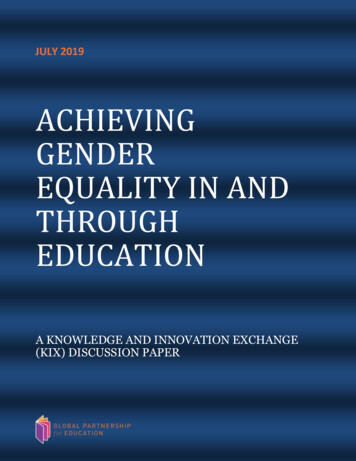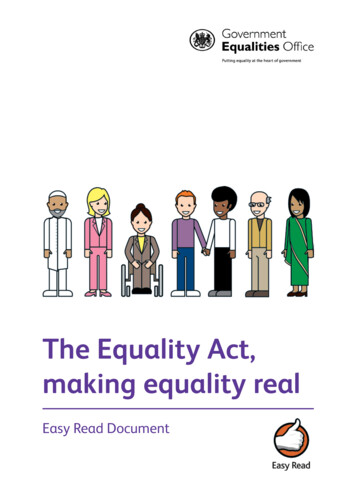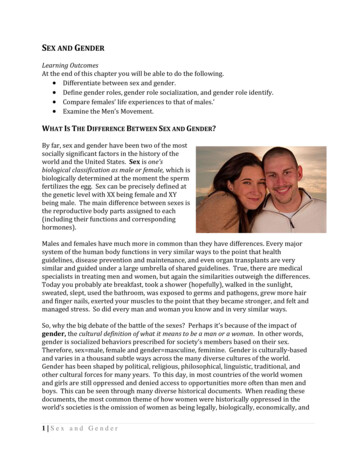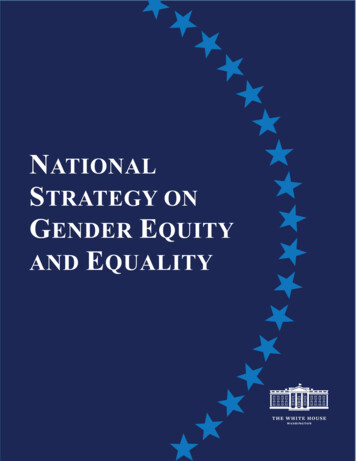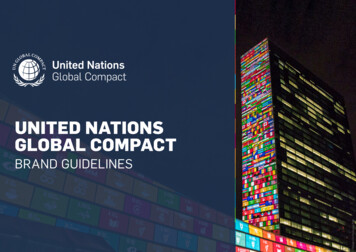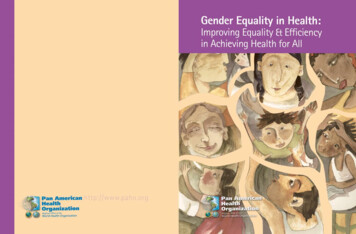
Transcription
Gender Equality in Health:Improving Equality & Efficiencyin Achieving Health for All
ContentsI. The What and Why of this BookletInformational Boxes3Gender Defined3A. Why Do We Have to Integrate Gender?1. WHO and PAHO2. Human rights conventions3. Good programming3345Human Rights Documents4Suggested Components Inclusive Programs5An Example of a Program that Succeeded6B. How Gender Impacts Outcomes/Status1. Health Research2. Poverty3. Reproductive Health Policies4. Stereotypes67889Adolescent Girls and Social Barriers8“Program for women”8Gender Blind, Sensitive, or Transformative?10C. Responding to Challenges10Considerations for Data Collection11II. Some Tools for Integrating Gender11Considerations for Data Analysis12A. Planning Effective Programs1. Data Collection2. Data Analysis3. Program Development4. Products and Services Selection5. Examples of Products/Services11 Considerations for Program Development1112 Considerations for Products and Services1213 Considerations for Budgeting14Example of a Transformational ProgramB. Implementing Transformative Program 161. Resource Mobilization162. Program Implementation17C. Monitoring & Evaluating Integration1. Stakeholder Communication2. Tool for Evaluating Programs131617181818Images and TablesAnnexes and Additional InformationFig. I: Areas to implement Gender Equality Policy 4Annex I – Some MisconceptionsFig. II: PAHO's Gender Matrix7Annex IIFig. III: Gender Analysis contributions10Fig. IV: Integrating gender throughout programs11Text by Genevieve Grabman and Sara Friedman, layout compiled by Rebecca Grabman-2-122023
I. The What and Whyof this BookletThis booklet offers information to help program staffimprove their understanding of how social norms, roles,and inequities affect health outcomes for women, men,boys, and girls. The goal of this booklet is to assist staffto integrate gender in programs, products, and servicesso that these foster progressive changes in power relationships between women and men.Women and men are empowered through transformative programs that: acknowledge different norms and roles for womenand men and their impact on access to, and controlover resources take account of women’s and men’s specific needs; address causes of gender-based health inequities; include ways to change harmful gender norms,roles and relations; and aim to promote.The next few pages suggest tools and approaches to integrate gender in every aspect of health programming.Annex I addresses some of the many misconceptionsabout gender integration in health programs.Gender Defined Gender describes those characteristics ofwomen and men that are socially constructed, while sex refers to those that are biologically determined. Gender Equality in health means thatwomen and men have equal opportunitiesfor realizing their full rights and potentialto be healthy, contribute to health development, and benefit from the results. Gender Inequity in health refers to thoseinequalities between women and men inhealth status, health care, and health workparticipation, which are unjust, unnecessary, and avoidable. Equity is the means;equality is the result. Gender Analysis in health examines theinteraction of biological and socio-culturalfactors to highlight how they positively ornegatively affect health behaviors, risks andoutcomes, access and control over healthresources, and contribution to care.A. Why Do We Have to Integrate Gender into Our Health Programs, Products, and Services?1. WHO and PAHO require us to do soThe PAHO Directing Council adopted the Organization’s Gender Equality Policy to achieve gender equality inhealth status and health development. The Policy applies to all work throughout the organization and to all staffand Member States. The Policy is grounded in the WHO Gender Policy and WHO Constitution, which declares,“The enjoyment of the highest attainable standards of health is one of the fundamental rights of every human being.”You can read PAHO’s Gender Equity Policy alityPolicy2005.pdfThe five-year PAHO Plan of Action on Gender Equality supports the Secretariat and Member States to fulfill theircommitments under the Gender Equality Policy. As shown in Figure I, a gender perspective will be integrated inall phases of-3-
EvidencebuildingGender Equality Policy Goal:Achievement of gender equality in healthstatus and health developmentParticipationof civilsocietyCore Objectives: Optimal health status and well being for men and women Equity in resources allocations for healthInstitutionalization,monitoring andevaluation Equal participation and empowerment of men and women inrelation to their health Fairness in distribution of burden and rewardsassociated with health work for men and womenCapacitybuildingFig. I: Four strategic areas to implementthe Gender Equality Policy2. Human rights conventions require us to do soPAHO’s Gender Equality Policy is consistent with United Nations and Inter-American human rights conventionsand protocols. Human rights accords demand that health programs recognize and address women’s and men’s,and boys' and girls', different needs, unequal access to resources, and control over resources. In 2008, the Organization of American States called for protection of human rights regardless of sexual orientation or gender identity.Human Rights Documents Supporting Gender Integration in the Right to Health-4- International Covenant on Social, Economic, and Cultural Rights Convention on the Elimination of All Forms of Discrimination against Women (CEDAW) Protocol to Prevent, Suppress, and Punish Trafficking in Persons, Especially Women and Children Inter-American Convention on the Prevention, Punishment, and Eradication of Violence againstWomen (Convention of Belem do Para) United Nations Declaration on Sexual Orientation and Gender Identity (proposed)
3. Good programming requires us to do so.Programs that address equality in health acknowledge and challenge social roles and discrimination that impactthe health status of women and men, girls and boys. Health programs that promote gender equality do not aim toeliminate differences between women and men. However, removing preventable biases between the sexes willachieve fairness and justice in distribution of benefits, power, resources, and responsibilities.Gender integration is not a separate health program; it is a way of looking at and addressing needs across sectors.Effective health programs are those that respond to the different needs and situations of women, men, girls andboys, and benefit everyone. Appreciating the implications and impact of gender roles, norms and discriminationon health will enable health practitioners and planners to serve the health needs of the populations targeted by ahealth program. Conversely, health programs that do not integrate gender cannot address adequately health conditions and, consequently, will fail.Suggested Components of a Gender Inclusive Health Program A lifecycle approach to health of both women and men from birth onward. An integrated, comprehensive, holistic and multisectoral approach that looks beyond medical services to the whole human being. Research and clinical trials on women’s diseases and responses and include women as healthcaredecision makers and authors of this work. A solid evidence base that exposes gender-based differences and outcome indicators and considergender as a cross-cutting issue alongside otherof inequity in health, such as poverty, age,ethnic diversity Control and decision making of women and adolescent girls over their rights and reproductivehealth, including FP, addressing unsafe pregnancies and abortions, spacing. Sensitization of health workers, government officials, PAHO staff, men and boys to the harm causedviolence against girls and women, and on themselves. Education, counseling and empowerment of women and adolescent girls about their rights and howto Extra services for the poorest women and men, including for culturally diverse peoples and minorities. Recognition of the contribution of women and men to the provision of paid and unpaid health care.-5-
An Example of a Program that Succeeded Because it Integrated GenderDiabetes Prevention and Control in MexicoIn Mexico, diabetes mellitus is the leading cause of death for men and women and the primaryreason men and women seek medical care. Diabetes is prevalent in ten percent of the Mexican population, but women with diabetes are more likely to die from it. In 2003, the Government designed anddisseminated a gender-blind brochure to stress the importance of reducing abdominal fat, the main contributor to increased diabetes risk. Despite this campaign, however, mortality from diabetes continuedto increase, especially for women.A 2006 study revealed that women and men have different views and habits of nourishment, physical activity, and care of their bodies. Based on this study, the Mexican National Center for Gender Equity and Reproductive Health reformatted the informational brochure to create one targeted to womenand another to men. The women’s brochure and accompanying DVD sought to address stereotypesthat exercise is not a feminine activity, and the brochure included a series of fun, simple, and no-costexercises. The men’s brochure and DVD highlighted stereotypes that lead men to adopt risky behaviorsand to ignore disease symptoms. The brochures and DVDs are disseminated to male and female healthservice users.The gender-specific brochures were a success. Focus groups praised the material, with both menand women reporting they remembered the health messages in the particular brochure targeted to them.By 2008, health authorities reported that men and women made specific requests for the brochure “formen” or “for women” and that overall brochure dissemination had increased.for additional best practices on gender mainstreaming in health programs:http://new.paho.org/hq/index.php?option com content&task view&id 457&Itemid 259B. How Gender Impacts Health Outcomes and StatusHealth outcomes are shaped, on one hand, by biological considerations, and on the other hand, by socio-culturalconsiderations. The different biology of women and men has an obvious impact on health. Now, increasing evidence shows that roles and relationship based on male and female status, values, and behavior also can influencehealth.PAHO’s Gender Matrix can be used to sort through the biological and socio-cultural issues that affect women’sand men’s different health risks, access to heath care, and health outcomes. By employing lenses of genderanalysis to examine health challenges, one can determine whether there are gender differences in risk, care seeking, health provider responses, treatment compliance and completion, health outcomes, or social and economicconsequences of the health problem. Analysis using the Gender Matrix, at Figure II, helps identify effectiveinterventions that both respond to health needs.-6-
Lenses of gender analysisHealth ProblemHow do biological/physiological differeces between sexesinfluence men's and women's:How do gender norms/values affect men's and women's(boys' and girls'):Health risks and vulnerabilityAbility to access and use healthservices/resoucesHealth outcomes / consequences of health problem (e.g. economic, social)Fig. II: PAHO's Gender MatrixFour examples that demonstrate the interplay of gender and health are health research, poverty, healthcare policyand laws, and stereotypes. Using the Gender Matrix to think about these examples illuminates the following:1. Health ResearchFor decades, research and clinical trials involving only men were used to develop treatments and medicationsprescribed for men and women. Yet, it is a mistake to assume that women and men experience illness and reactto medicine in the same way.Female and male anatomy and physiology determine risk for different diseases and differing responses to thesame diseases, medications, or treatment. For example, cervical cancer and childbearingunique to women'sreproductive function and anatomy, as prostate and testicular cancer relate only to men’s anatomy. Femalebody structures place girls and women at higher risk for HIV transmission through heterosexual intercourse;men’s physiology places them at greater HIV transmission risk through sex with men. And, although both sexesexperience coronary disease, women’s smaller arteries make angioplasty a riskier treatment.Gender norms also influence men’s and women’s behaviors, risk factors, and disease response. As an illustration, men may smoke to be macho; women may smoke to feel attractive. Men disproportionately use alcohol andtobacco and are injured or die from traffic accidents or violent events. Women report more depression. Tradi tions that encourage sex between older men and adolescent girls lead to high rates of unplanned pregnancies andGender blind research might really be based on male physiology and norms, leading to inappropriate or ineffective treatment for women and men.-7-
2. PovertyThe vicious cycle of poverty and poor health especially affects women, and is perpetuated by gender roles.Latin America and the Caribbean (LAC) is a region where girls are better educated than boys. Usually, educationrate correlate with more wealth. But in LAC, women earn one-third less than men and are disproportionatelypoor. Women work in the lowest paid and informal sectors and carry the heaviest burden of unpaid houseworkand home care. The region’s 75 million indigenous women are poor and suffer dismal health outcomes. Forexample, maternal mortality in Panama is overall 70 out of 100,000 live births; but 658 indigenousforCompounding their economic disadvantage, women pay more for their health care. Health services provided towomen are not more expensive than those provided to men. But women’s employment is less likely to provideher health insurance, requiring women to pay out-of-pocket for healthcare. Women’s greater longevityreproductive role requires more total health care across their lifespan to managetions. These combined liabilities set in motion adownward spiral that lessens women’s ability to“Program for women” does not mean genderafford medications and care,integration. Programs must address power imhealth services, and increases women’sbalances and how women and men are affected.poverty. In turn, increased povertywomen’s ability to pay for neededworsens3. Reproductive Health Policies and LawsNowhere do established gender roles have a larger impact than in reproductive health policy and laws. Ignoringthe unique health needs of women and girls only further marginalizes them, and ignoring the needs of men andboys compromises their own health and the health of their sexual partners.Although society supports reproductive roles and responsibilities for women, it often erects barriers to women’sreproductive health. Thousands of women die each year in LAC due to unsafe abortions, bleeding, obstructedlabor, eclampsia, and fistula. Most of these maternal deaths are entirely preventable through timely treatment,but investmentin the transportation,clinics, and skilled birth attendants necessary to provideaccess to care.Adolescent Girls and Social BarriersExpectations of chaste behavior results in strictlaws and denial of sexual health services andinformation to adolescent girls. Such restrictions are blind to the reality of adolescents’sexual activity and ensuing risks. The common and socially accepted practice of sex witholder men leads to unwanted, unsafe pregnancy and, in many countries, a rate of HIV incidence that is double that of adolescent girls’male cohorts. The view, unmoored by supporting evidence, that providing information andservices will only encourage promiscuity isresponsible for limiting the development andhealth of many adolescent girls.-8-Health workers’ attitudes may also reduce health seeking behavior. Men may avoid obtaining condoms or being tested for sexually transmitted infections because ofcontemptuous attitudes of health workers. Or, preferring to give birth in a more traditional standing position,indigenous women may refuse to go to a maternity clinic that insists on strapping labouring women into bed.Many governments restrict reproductive health servicesby criminalizing abortion and prohibiting the provisionof emergency contraception. These legal prohibitions offamily planning information, contraception, and abortion not only violate the human rights to determine thespacing and number of children, but also contribute tomany deaths.
4. StereotypesThe health of men and women is harmed by stereotypical standards of masculinity that include uncontested powerand aggressive risk taking.As a result of this behavior, men and boys are at greater risk of injury and death from accidents and violence.Men also experience higher rates of substance abuse and its consequences, such as lung cancer, liver cirrhosis,and increased risky sex. The rigid rules of masculinity may discourage men from health-seeking behavior to protect them from injury to comply with disease treatment. Machismo also deprives men of exploring and enjoyingnurturing and compassion, discouraging them from being active and involved with the planning and care of theirfamily.Prioritizing hypermasculinity further results in stigmatizing men and boys who do not live up to these standards.Homophobia in the LAC region exacts a heavy toll on the health of homosexual, bisexual, and transgendered men.Although no countries in the region criminalize homosexuality, men who have sex with men are still shamed,ostracized, fired from jobs, and barred from many activities, making them reluctant to seek health care. With sexbetween men the principle mode of HIV transmission in the region, homophobia is clearly a major stumblingblock to effective response of the epidemic and to the overall wellness of men and boys.Alarmingly, approximately one third of women in the LAC region have been victims of sexual, physical or emotional violence at hands of intimate male partners. Although all LAC countries have ratified CEDAW and InterAmerican Convention on Prevention, Punishment and Eradication of Violence against Women, countries havenot vigorously prosecuted the perpetrators of gender-based violence. Society and legal systems incorrectly viewviolence as normal, not criminal.-9-
C. How to Respond to Health and Gender Challenges: Transformative Health ProgramsGender transformative health programs take into account the unique biological and socio-cultural experiences andneeds of women and men with the goal of equality. Achieving gender equality in health is a long-term processthat will have to overcome many challenges, including resistance to change among individuals, institutions, structures and budgets. But maintaining the status quo will reflect, reinforce, and perpetuate norms that marginalizewomen and harm the health of all.Gender analysis can be used to move health programs from being gender blind to gender transformative.Fig. III: Gender Analysis contributes to understanding andtransforming gender related issuesIs Your Health Program Gender Blind, Sensitive, or Transformative?Gender Blind programs. Do not consider gender relevant to development outcome Do not affect, for better or worse, gender norms, roles or relations Do not have interventions that address gender issues; instead, activities are aimed at the generalpopulation and carried out assuming equal access and participation of allGender Sensitive programs. Use gender Address gender roles, norms, and access to resources in so far as needed to reach project goals Introduce gender in interventions as needed to achieve project goals; activities made accessible toboth women and menGender Transformative programs. Make central promoting gender equity and achieving positive development outcomes Change unequal gender relations to promote shared power, control of resources, decision makingand support for women’s empowerment Include interventions that raise consciousness about unequal balance of power to promote transformation of relations; activities promote women’s increased authority/autonomy-10-
II. Some Tools for Integrating Gender into Health ProgramsKnowledge of how gender interacts with biological factors is a powerful tool for reducingthe burden of illness, improving the healthof women and men and improving the socialand economic status of women. Gender mustbe integrated throughout a health program,from the program’s initial data collectionand design, to the program’s implementation and resource mobilization, and throughthe program’s monitoring and evaluation thatinclude the active participation of men andwomen, as shown in Figure IV.Fig. IV: Integrating gender throughout health programsA. Planning and Formulating an Effective Program that Integrates GenderDesigning a health program that integrates gender takes five steps: identifying the health problem through collecting data disaggregated by sex; analyzing data with a gender perspective about this health problem; creatinga program that is consistent with international gender standards; and selecting intended outputs (or products andservices) to redress inequities1. Data Collection and GenderTo integrate gender in data collection, different techniquesshould be used to gather quantitative and qualitativesurveys, rapid appraisals, and focus groups. It is impor tant to expand data collection beyond existing statistics"Official data" may require improvement, as they may havehistorically ignored or undercounted women, indigenousgroups, orFocus groups and personal interviews are particularlymethods of collecting datawomen and menmay be unable to write down their experiences and recoll ections, but theseConsiderations for Data Collection Did data collection allow for fullparticipation of women and men ofdifferentand ethnic groups? Did data collection occur in a safeenvironment? Do data include information fromwomen andcivil society,community leaders, etc.?Who collects the data is also critical. Women might be morewilling to provide information to a female interviewer, mento a male interviewer. Consider the power dynamics between-11-
women and men at the data collection site. Perhaps women and men should be interviewed separately, especiallywhere men tend to dominate meetings or where women are hesitant to speak up.ge.2. Data Analysis and GenderOnce data are collected, they must be analyzed todetermine who is at risk for the health problem andwhy. From a gender perspective, a vital step of dataanalysis is disaggregation. Researchers should disaggregate data by sex, age, social and economic status,geographic location, ethnicity, and sexual identity toshow multiple links.Findings should be presented to key stakeholders,women and men, girls and boys in the communityfrom which the data were collected. Encourage thecommunity to comment on whether the findings mirror what the members know, or believe to be, the truehealth problems affecting them.Considerations for Data Analysis Do data reflect the situations of women andmen of different ages and cultures (ethnicities, immigrants, sexual orientations)? Do data reflect those who carry a greaterburden of illness, whose health may be morevulnerable, and who are more at risk? Do data explain the influence of genderroles on health of males and females in thesegroups?3. Program Development and GenderOnce data are collected and analyzed, then a healthprogram can be developed to address gaps and optimize health access and response. Include women andmen who will be affected by the program in the program’s planning, design, and advocacy.If the data reveal a gap in access to health services orconcerning a health situation, first consult the wisdomof international laws and agreements for guidance.Human rights documents provide information thatwill allow health programs to acknowledge and challenge gender roles that result in poor health. Additionally, gender standards described as binding obligationsmay provide health programs the gravitas necessary toobtain funding and to reconfigure vertical programs.The program should not merely give equal attentionto women and men under the guise of gender neutrality. Instead, it should focus on the differing needsand experiences of women and men, as these needsand experience have been illuminated by the dataand analysis underpinning the program. The programshould seek to change gender attitudes and behaviorsthat imperil health or that lead to risk for the healthproblem or limit access.Considerations for Program Development Is vulnerability to illness, disease, or healthcondition related to biology or gender roles? Where does this condition occur? Who becomes ill? What is the health seeking behavior of thoseaffected by the condition? How do access to and control over resourcesaffect provision of care? How do health services meet the needs ofwomen and men affected by this condition? What are the predominant health and socialoutcomes of this condition? What do human rights documents say aboutthis condition or the gender roles that affectit?The health program also should make extra efforts to include hard-to-reach populations, those people who havefallen through the cracks in previous attempts to address the particular health problem.-12-
4. Products and Services Selection and GenderIn PAHO's biennial work plans, products and servicesare the intended outputs – activities, materials –health program. Selection of products andbased on knowledge and informationevidence and program design.Gender-integrating products and services improvehealth seeking behaviors and increase access to healthservices. Appropriate outputs of a gender-integratinghealth program include selection of women to healthdecision making positions, training on attitudes forhealth workers to change underlying biases, andhealth information and education materials appropriate for men, women, boys, girls of diverse populations.Considerations for Products and Services Address different needs of men and women,girls and boys of diverse populations Target activities and information to addresswomen’s and men’s specific vulnerabilitiesto a disease or health condition Change attitudes of health providers Address obstacles to access to care Address gender roles that affect health behaviorsA gender-integrating product or service is not a stand-alone activity for or related to women. It isn't merely abrochure for women or attendence at a conference. It is not a children's or infant health intervention, unless theseactivities are targeted to boys or to girls. And a gender-integrating product is not one that only addresses "discrimination."Instead, a gender-integrating product or service addresses gender roles, relates to other activities, and is an integral component of a gender-transformative program. If seeking to combat discrimination, a gender-integratingproduct specifically addresses discrimination against women or against homo, bi, or transsexuals.-13-
5. Examples of Gender-Sensitive Products and ServicesHere are some good examples, from 2010-11 biennial work plans, of gender transformative products and services.SO/RERSuggested Product or ServiceSO1: Reduce the health, social and economic burdenof communicable diseases Separate, private school sanitation facilitiesprovided for girls.SO2: Combat HIV/AIDS, TB, and malaria Laws, regulations, or policies that ensure men,women, and adolescents’ equal access to maleand female condoms.SO3: Prevent and reduce disease, disability and premature death from chronic non-communicable conditions, mental disorders, violence, and injuries Funding mechanism to provide adequate services and access to justice and redress to victims of violence against women.National plan of prevention and control of cervical cancer, with emphasis on rural women.SO4: Reduce morbidity and mortality and improvehealth during key stages of life, including pregnancy, childbirth, the neonatal period, childhood andadolescence, and improve sexual and reproductivehealth and promote active and health aging for allindividuals Maternal health professionals trained in family planning.SO5: Reduce the health consequences of emergencies, disasters, crises and conflicts, and minimizetheir social and economic impact Promotion of emergency contraception.SO6: Promote health and development, and preventor reduce risk factors, such as use of tobacco, alcohol, drugs and other psychoactive substances,unhealthy diets, physical inactivity and unsafe sex,which affect health conditions Curriculum for men to educate about risks ofsubstance abuse.Technical cooperation for developing pictorialhealth warnings on tobacco products takinginto account gender and ethnicity.SO7: Address the social and economic determinantsof health through policies and programs that enhance health equity and integrate pro-poor, genderresponsive, and human rights-based approaches Adult education programs for women to improve health literacy.SO8: Promote a healthier environment, intensify primary prevention and influence public policies in allsectors so as to address the root causes of environmental threats to health Studies of particular environmental threatsto determine differing impact on women andmen.-14-
SO/RERSuggested Product or ServiceSO9: Improve nutrition, food safety, and food security throughout the life-course, and in support ofpublic health and sustainable development Programs that describe and address securityrisks that result in men or women’s loss offood.SO10 and SO11: Improve the organization, management, and delivery of health services; strengthenleadership, governance, and the evidence base ofhealth systems Community plans, supported with adequatecommunication, facilities and transportationsystems, to connect laboring women with obstetric care, especially in
outcomes, access and control over health resources, and contribution to care.-4-2. Human rights conventions require us to do so PAHO's Gender Equality Policy is consistent with United Nations and Inter-American human rights conventions and protocols. Human rights accords demand that health programs recognize and address women's and men's,

